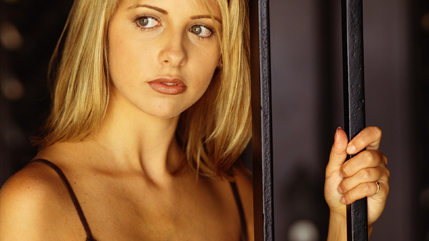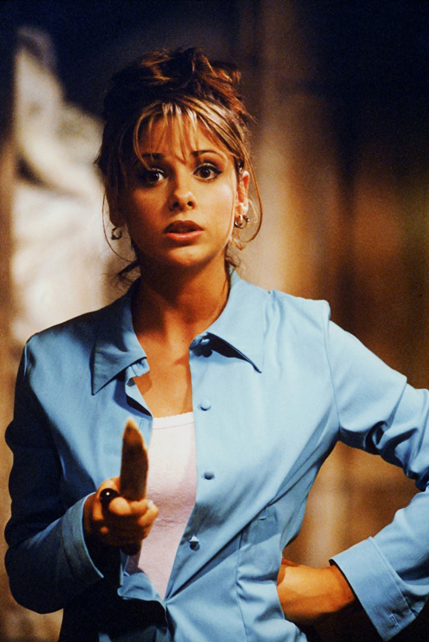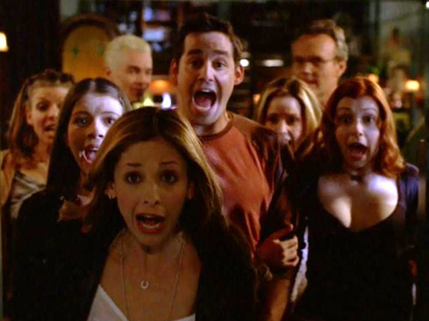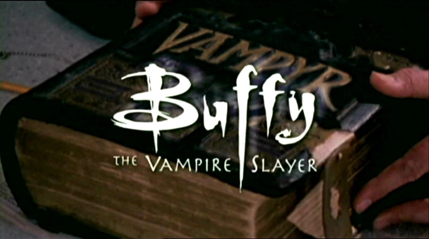Buffy the Vampire Slayer : Kicking Ass and Staking Names
“Why do you write strong female characters?”
“Because you’re still asking me that question.”
Twenty years ago, in 1992, a film was released that had a slightly different slant on the horror idiom. The cute blonde school girl was not the victim. As the website-breaking title suggests, she turned out, once she had accepted her ‘calling’, to kick serious vampire arse.
The film wasn’t great (although I still cite it as having the best hammed up, protracted death scene of all time). But it was the true beginning of ‘Buffy’.
Joss Whedon, like many of us, was a little tired of the heroines being there simply as eye candy and / or victims. So he set about creating a character that was cute and girly, but kicked serious arse; and in 1992, she cart-wheeled and flipped into our consciousness. But Kristy Swanson was not to wear the crown.
Five years later, in 1997, Buffy the Vampire Slayer hit the small screen, and took it by storm. This time Sarah Michelle Gellar took the lead role. Supported by Alyson Hannigan and Nicholas Brendon, they (and Mr Whedon) created a tale that captured our imaginations for seven seasons on TV (and one more in comic book form), plus gave rise to the spin-off Angel.
Buffy ended its TV run in 2003. But it is still considered a seminal work in the TV horror industry. Why is this? Yes, the writing was superb: a beautiful balance of humour and fear. Well crafted characters that we fell in love with. And excellent performances that really brought it all together. We cared about what happened in the lives of Willow (Hannigan), Xander (Brendon), Angel (David Boreanz), Spike (James Marsters) and many others that came and went.
But the one thing that brought it all together was the story. Not the weekly goings-on that kept us entertained, but the growth of the girl, ripped from her teenage years to become the defender of the world. How she grew, developed, adapted and dealt with the pressures and horrors that she was forced to live with. We watched her live, grow, die (twice), sing (badly) and save the world on a semi-regular basis. She loved and lost. She pissed off her friends, and fixed it. She screwed up royally and pulled it back. She was human. She was the chosen one and kicked serious butt, but she felt real.
But the greatest thing about the tale, and one that is now often overlooked? She was a she.
Before Buffy there were heroines. But they almost always were portrayed in a ‘look, it’s a girl!’ kind-of-way. If you wanted character development, your star was a guy. Otherwise it was all about kicking butt (I refer you to Milla Jovovitch in the Resident Evil films). Oh yes, there are female leads in many shows of the age. But they generally turn to a bloke to do the heavy lifting. Buffy was the first show to treat her as a hero and a person, and has spawned many attempts to create the same balance. But none have achieved it quite as well as Mr Whedon.
Of course, with any form of media that carries a message, there is always a risk that the message can come across too heavy-handedly; more often than not consequently doing more harm than good. Just think of The Happening. This is where Whedon’s particular knack of writing such engaging characters comes to the fore – despite the show’s original intention to subvert the formulaic damsel-in-distress archetype, Whedon manages to tread the fine line dividing subtlety and pantomime. Sure, Buffy might be pretty kick-ass, but at the same time she retains a level of vulnerability that still allows the audience to engage with her as a person.
Which rather neatly brings us to the significance of this article; Women in Horror Recognition Month. There has been a lot of writing done on feminism in Buffy the Vampire Slayer, both in favour and in opposition. The former camp cite, amongst others, the strong female protagonist and the appearance of a lesbian as a main character; the latter, Buffy’s penchant for figure-revealing clothing and desire for patriarchal affirmation. Now at the risk of putting a lot of people off, I’m not going to get into too much detail regarding the feminism debate in this article (not to mention the fact that I’m not all knowledgeable enough to be able to); primarily, Women in Horror Recognition Month is about acknowledging and promoting equality between genders, and in that sense, Buffy deserves a mention. Specifics and nit-picking aside, Buffy the Vampire Slayer features (and indeed, has almost become synonymous with) a strong, almost indomitable female lead, and – to me, at least – that is more than enough to count. Sure, Xander may be rather misogynistic, for example, but no-one wants a show in which all the characters are paragons of All That Is Good and Right. That’s not how drama works. Don’t forget that Xander’s misogyny lies in a deep-rooted insecurity; one could argue that despite all his immaturity (and the fact that he never actually receives any retribution for this misogyny), he’s never looked at as anything more than the clown of the group; never really amounting to anything of power.
Anyway, I’m being sidetracked; one of the things that sets Buffy apart from other similar mass-media heroines of television is that, in the confines of the show at least, she never is portrayed as overtly sexualised – certainly not in the same way that Lucy Lawless’ Xena was, for example. I think this is the key factor that makes Buffy the Vampire Slayer so important. It goes without saying that Xena et al are strong, powerful women, but their appearances were clearly designed with a male gaze in mind. Buffy, however, never succumbs to this; sure, she dresses fashionably, but that’s entirely keeping within her character as a high-school teenager. She manages to kick all sorts of demonic arse without sacrificing her femininity; and I think this is very important. She, as a character, takes on a more traditionally ‘masculine’ role whilst still embracing what makes her a woman, and this is a key factor when addressing Buffy as a feminist role model; indeed, remove her too much from the high school paradigm and the (chiefly teenage and young adult) audience won’t be able to connect to her nearly as well.
A lot of ‘Buffy-as-anti-feminist’ advocates argue the fact that Sarah Michelle Gellar is just too gosh-darn good looking to make a good feminist role model; by casting an attractive actress as Buffy, she as a character would always be subjected to the ‘lecherous male gaze’, thus rendering any feminist leanings as self-sabotaging. However, I think it’s naive to argue this without looking at the opposite sex: tell the truth – how many of you had a crush on David Boreanaz? Or Seth Green? Or – hell – even James Marsters? Casting an attractive actress as Buffy shouldn’t reflect upon Buffy as a feminist role model, because it’s just the way marketing in the world of television works. What’s important is how the character is portrayed, and it’s this dichotomy between bubblegum teenager and vampire slayer that, in my opinion, makes Buffy such a good character, and consequently makes the show so popular.
Preserving this accessibility allows for all sorts of parallels to be drawn between Sunnydale’s hellish goings-on and day-to-day high school occurrences: “In the world of Buffy the problems that teenagers face become literal monsters. A mother can take over her daughter’s life; a strict stepfather-to-be is really a heartless machine; a young lesbian fears that her nature is demonic; a girl who has sex with even the nicest-seeming guy may discover that he afterwards becomes a monster.” This is perhaps one of the reasons that made Buffy the Vampire Slayer such a popular show; its multitextural nature allowed for it to be seen as a modern-day fable whilst still providing a very engaging narrative. This is particularly true of the early episodes, where it very much followed a ‘monster of the week’ structure – the chop and change nature of these episodes allowed for a different social situation (and consequently a different moral) to be addressed each week. Whilst some of these fables may come across as somewhat heavy-handed (I’m looking at you, Beer Bad), I think their relatability played an important role in building the initial fanbase of Buffy.
As the seasons progressed, however, this composition gradually gave way to a more serial-oriented narrative, with epic overarching story arcs, and as such this very X-Files-y ‘monster of the week’ style of narrative was largely lost. However, the seeds of adoration had already been sown and the popularity of Buffy rocketed. It was at this point that the characters started to get more interesting; the serialisation of the show allowed for more character development than before…and with that character development came internal conflict and, consequently, drama. And the latter seasons had drama in spadeloads, especially as the show began to get increasingly darker and began dealing with more and more serious situations: abusive relationships, loss of family members (who could forget), musical theatre…the list goes on. However, despite the bleak storylines that had been woven, Buffy never really lost that very Whedonesque sense of humour that made it so popular in the heady days of season one. Say what you want about the man, but Whedon sure knows how to write characters you fall in love with.
What I always found interesting about Buffy is how well it managed to put its own spin on well-known stories, whether they be novels, movies, short stories, folklore…to explore and explain all the pop-culture intertextuality referenced in all seven seasons would require its own separate article – nay, its own separate website – but regardless of the specific references, what’s important is the familiarity that comes hand-in-hand with it. Because Buffy thrives in 90’s postmodernism – all nods and knowing winks – it manages to both subvert and embrace mainstream horror culture, half-pastiche, half-satire; telling a new story whilst all the while treading a somewhat familiar ground.
You just need to take a look at the opening credits to see this duality in action. Each episode, without fail, the credits open, wolves a-howling and gothic imagery a-gothicking (backed by a four-note melody played on a church organ), before letting loose with a blast of punk music echoing the tune established by the organ. By embracing the schlockiness of classic horror tropes before hammering them bang up to date, we instantly got a sense of Buffy’s postmodern intertextuality.
In some respects it can be argued that this is rather an unoriginal method of storytelling, but as with any self-aware media, it’s not necessarily the content that matters, rather how the content is used…which, of course, harks back to Whedon’s original intention; indeed, his inspiration for Buffy as a character was, in fact, horror pop-culture and the way femininity was represented within it. By embracing Buffy’s origins as a character sat within a wider context, she becomes a vessel through which a message is conveyed. The world of Buffy needs these familiar tropes; remove the references and you remove the show’s capacity to comment on their progenitors.
For brevity’s sake I’m going to wind up this article for now, but don’t get me wrong: Buffy the Vampire Slayer was an epic, eight-season, six year-spanning show. I’ve barely touched the surface of the sheer depth of discussion that can be had on Buffy and the various characters within. But actually? That’s largely beside the point. As a character, Buffy may be flawed. She may be weak. She may be vulnerable. But these moments pale into comparison when you look at all the times she just totally kicked ass. Regardless of whether it can be argued that Buffy is a feminist show or not, no-one can deny the fact that it’s become synonymous with an exceptionally strong female lead. And you know what? That’s enough for me.










Thanks go to resident Gorepress reviewer Matt Blythe for helping to write this article!
Meh. I did diddley. Phil did the heavy lifting. But just wait for my equally insightful piece on ‘Charmed’.
Heheheh… Sorry, I couldn’t keep a straight face.
So love Buffy and so miss…) This is the best TV show i ever saw!
Thank you for this post!
Hey Laura! Glad to hear you liked it
Buffy was the best. The best TV can get